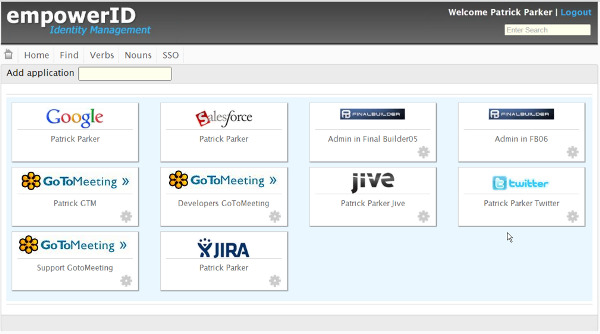 Reading an article by Earl Perkins titled Data Meets Applications in Identity and Access Governance, I was struck by the distinction he makes between application and data access governance. From an IAM professional's point of view, they should be one and the same thing...access to resources for their users.
Reading an article by Earl Perkins titled Data Meets Applications in Identity and Access Governance, I was struck by the distinction he makes between application and data access governance. From an IAM professional's point of view, they should be one and the same thing...access to resources for their users.
But, apparently, our competitors haven't always thought that way. He talks about how IAM suite vendors (we are one) are squeezing out point solutions by buying companies and product lines to integrate data access governance into traditional IAM. EmpowerID is one step ahead of that curve (at least one step!).
EmpowerID's platform incorporates role based access control (RBAC) into all aspects of IAM: provisioning, authentication, synchronization, and, yes, access governance. This ability to manage any IAM workflow based on roles or even attributes (ABAC) and integrate them into any IAM process is what makes our access governance abilities unique.
We don't have to distinguish between data and application access when granting privileges. Either are simply resources to empowerID. The same role structure, the same access request workflows, the same user interfaces apply whether asking for access to Salesforce.com or that folder in the Windows file system, or the shared Exchange mailbox.
If your role has access, you have access. If you want to request access, it is the same UI and a resource-appopriate approval process.
For data access governance, we have taken it one step further. Most solutions offer you one of two ways to request access: 1) request access to a file or folder, or 2) request access to the group that is granting access. EmpowerID adds the option of requesting access to a role.
No two users think of this process in the same way. Those who prefer option 1 think of it as, "I need access to that data", those who prefer option 2 think, "what do I need to get access to data", and the third think, "who gets access to that data."
An access governance solution should be able to provide all three options (within limits of course) to satisfy the left brain, the right brain and the all brain thinkers. Not just for data but application access as well.
I dislike square peg round hole situations. If you consider your access governance and IAM solution to be a peg, make it malleable to fit your own businesss situations, processes and policies. Let us show you a personalized demonstration to see how empowerID can fit into your business and improve access governance.

 The first part that is out of control is that individual business units can go out and contract with a cloud application; they don't necessarily need to rely on IT to install it and configure it. They usually get a web-based management console and take to doing the provisioning & deprovisioning manually despite there being a much smarter way to handle it.
The first part that is out of control is that individual business units can go out and contract with a cloud application; they don't necessarily need to rely on IT to install it and configure it. They usually get a web-based management console and take to doing the provisioning & deprovisioning manually despite there being a much smarter way to handle it.

 The biggest benefit to attribute based access control (ABAC) is its flexibility. You basically are assigning permissions to anyone who meets a certain criteria. Dynamically. As soon as you change a person's job, location, employment status, any attribute in any system you want, you are changing their permissions.
The biggest benefit to attribute based access control (ABAC) is its flexibility. You basically are assigning permissions to anyone who meets a certain criteria. Dynamically. As soon as you change a person's job, location, employment status, any attribute in any system you want, you are changing their permissions.
 As George Orwell said, "All animals are equal but some animals are more equal than others." How does this apply to resetting passwords? Everyone needs passwords reset, but some need a little extra security around their password resetting.
As George Orwell said, "All animals are equal but some animals are more equal than others." How does this apply to resetting passwords? Everyone needs passwords reset, but some need a little extra security around their password resetting.
 Your finance department is watching the cloud. Not because they are tech literate and following IT trends, but because they can cut your budget quickly with cloud applications. And it's up to you to help them before they help themselves.
Your finance department is watching the cloud. Not because they are tech literate and following IT trends, but because they can cut your budget quickly with cloud applications. And it's up to you to help them before they help themselves.

 Until you observe and measure your IAM practices and policies, you don't know if the right people have the right access. And you don't know if the wrong people got the wrong access. That is where auditing actually helps your business, not just satisfying a regulatory requirement.
Until you observe and measure your IAM practices and policies, you don't know if the right people have the right access. And you don't know if the wrong people got the wrong access. That is where auditing actually helps your business, not just satisfying a regulatory requirement.
 Delegate and Automate. The first two words of IT. It is especially true with respect to managing Active Directory. There are a lot of authoritative sources of identity information that Active Directory needs and not one of them is your help desk employees.
Delegate and Automate. The first two words of IT. It is especially true with respect to managing Active Directory. There are a lot of authoritative sources of identity information that Active Directory needs and not one of them is your help desk employees.
 Not all applications are created equal. Not all users are created equal. Different users need access to different applications; different users need different access to these applications. We call this
Not all applications are created equal. Not all users are created equal. Different users need access to different applications; different users need different access to these applications. We call this  Active Directory groups are essential for fileshare permissions, for email communications, a few GPOs, and just plain useful for some application permissions. You can use them for SharePoint, though I recommend
Active Directory groups are essential for fileshare permissions, for email communications, a few GPOs, and just plain useful for some application permissions. You can use them for SharePoint, though I recommend 


